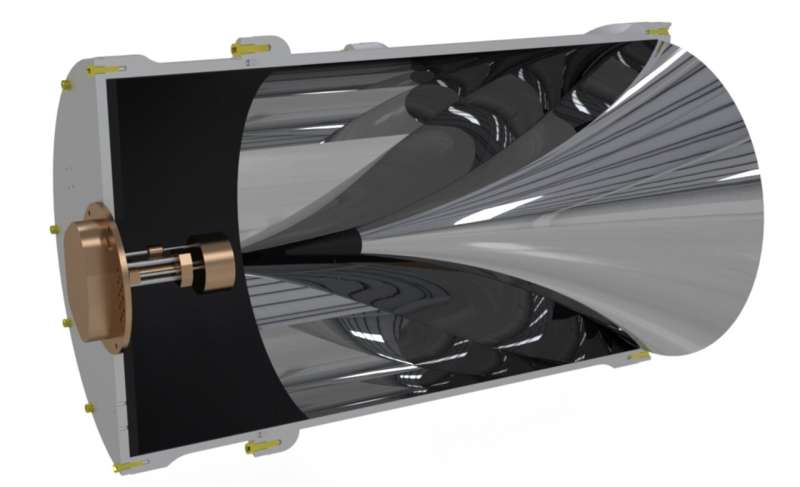May 3, 2024 feature
This article has been reviewed according to Science X's editorial process and policies. Editors have highlighted the following attributes while ensuring the content's credibility:
fact-checked
peer-reviewed publication
trusted source
proofread
The BREAD Collaboration is searching for dark photons using a coaxial dish antenna

Approximately 80% of the matter in the universe is predicted to be so-called "dark matter," which does not emit, reflect, or absorb light and thus cannot be directly detected using conventional experimental techniques.
While the existence of dark matter is now well-documented, astrophysicists worldwide are still trying to devise effective methods to detect it and confirm its composition.
The Broadband Reflector Experiment for Axion Detection (BREAD), a recently established research project ran by physicists at University of Chicago and the Fermi Accelerator Laboratory, introduced a new approach to search for light dark matter candidates, including dark photons and axions.
The method proposed by the BREAD Collaboration, outlined in a paper published in Physical Review Letters, entails the use of a coaxial dish antenna to pick up signals that would be associated with these particles.
"We know there is a form of matter around us which interacts only very weaky and does not radiate, but we don't know what it is made from," Stefan Knirck, corresponding author for the BREAD Collaboration, told Phys.org.
"There has been a lot of effort to search for new fundamental particles with a similar mass than a proton over the last few decades, but with little success. Therefore, we turn to other very well motivated candidates: the dark photon and the axion."
Dark photons and axions are theorized to be approximately 1 trillion times lighter than protons, thus their detection would require very different technologies. While the BREAD collaboration is still at its infancy, it introduced one new technology designed to search for these lighter particles. The objective of the recent study by Knirck and his colleagues was to start testing this technology in an initial small-scale experiment.
"The idea behind our work is that if axion (or in the case of this paper, dark photon) dark matter exists, it can convert to particles of light (photons) on a metallic wall," Knirck explained. "The photons are emitted perpendicular to the wall.
"In BREAD, the outer cylinder corresponds to this wall. All this light is then focused onto a small spot where you can put a light detector or antenna to search for a signal. In BREAD, the combination of the inner teardrop-shaped reflector and the outer cylinder take care of the focusing."
To make the set-up sensitive to axion dark matter, the BREAD Collaboration could also add a magnetic field that is parallel to the metallic wall in a future version of the experiment. A unique characteristic of the new detector is that it can fit in very large (m-scale) high-field (multi-Tesla) solenoid magnets.
"In this first experiment, we focused on detecting 'light' in the microwave regime, similar to the microwaves that are used when you heat up food at home," Knirck said. "To this end, we designed a custom microwave antenna at the focal spot and a very sensitive scheme to see the smallest powers received by the antenna. This leveraged leading quantum electronics development ongoing at Fermilab."
The BREAD Collaboration collected their first round of data last summer, specifically between June and July 2023. The data they gathered includes the thermal noise picked up by the antenna during this period and some added noise from amplification.
"Within this noise a signal would be tiny excess, which we searched for in our analysis," Knirck said. "This is similar to turning the frequency knob on a radio: If there is no station at a given frequency you hear noise, but when you slowly tune it to a station, you can hear the signal of the station starting to dominate over the noise."
The recent paper published by Knirck and his collaborators outlines the results of their first search for dark photons using this new detector. While they did not pick up any relevant signal, their experiment was found to be around 10,000 times more sensitive to the dark photon signal power within a mass ranging from 44 to 52 μeV (10.7–12.5 GHz) than previously proposed methods.
"Our work demonstrates the potential of this concept and sets us up to scale it up and make it much more sensitive in the future," Knirck said. "This motivates to keep developing this technology with much better sensitivity over much larger ranges of different dark matter masses."
The BREAD Collaboration hopes that their newly devised approach will allow them to
explore the most well-motivated axion models and potentially lead to their detection, which would be a huge breakthrough in particle astrophysics.
The researchers are now running their experiment in a 4T magnet at Argonne National Laboratory, to unlock its sensitivity to axion-like dark matter.
"We are also building more prototypes combining the concept with different cutting-edge quantum technology to be sensitive to single particles of light at the focus," Knirck added. "At Fermilab we soon expect to receive an even more powerful magnet which will make our experiments much more sensitive.
"The long-term goal is a large-scale experimental program with a setup on the ~10m scale inside a huge magnet allowing to explore the best-motivated models."
More information: Stefan Knirck et al, First Results from a Broadband Search for Dark Photon Dark Matter in the 44 to 52 μeV Range with a Coaxial Dish Antenna, Physical Review Letters (2024). DOI: 10.1103/PhysRevLett.132.131004
Journal information: Physical Review Letters
© 2024 Science X Network





















